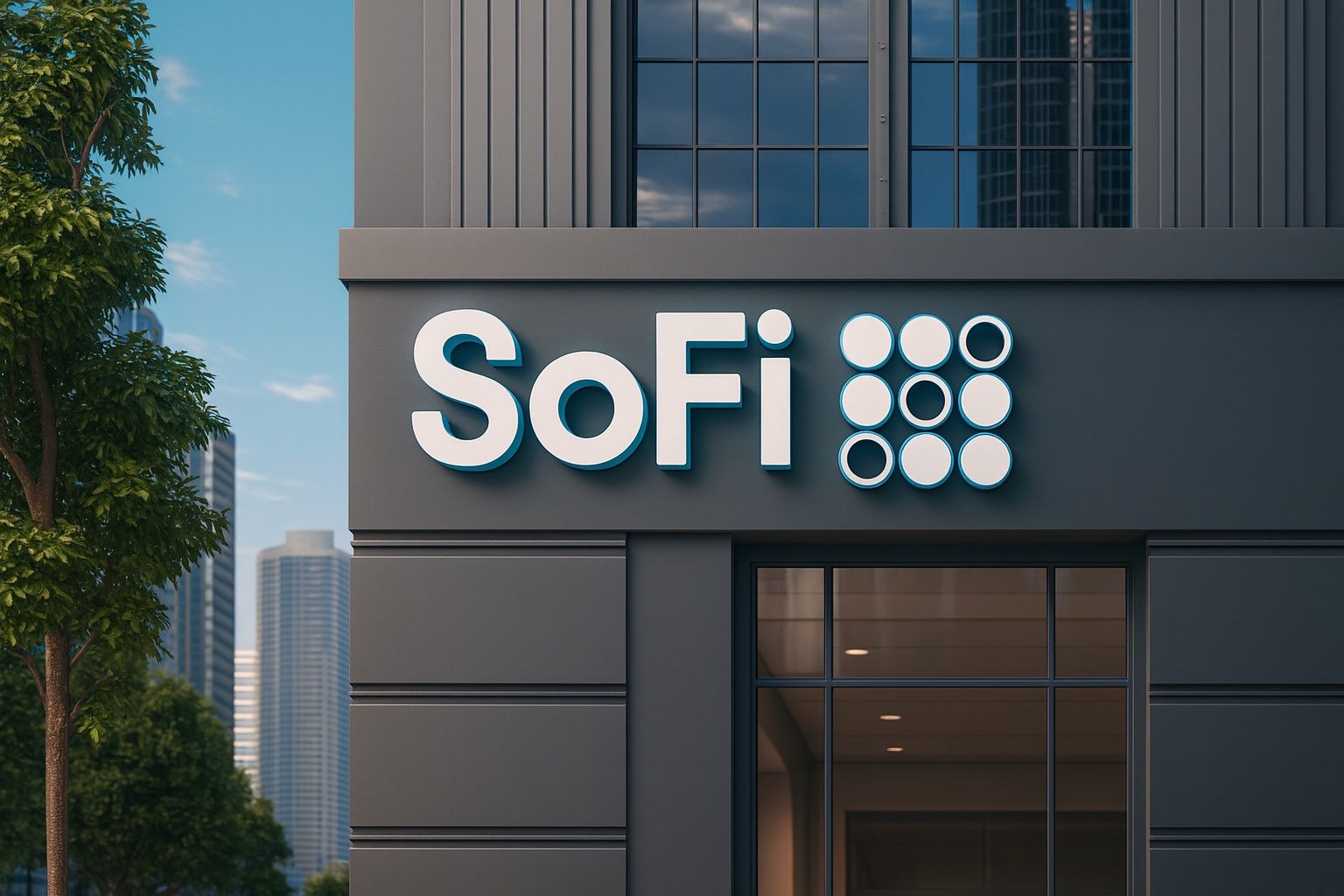- Explosive Rally: SOFI has more than tripled in the past year (up ~230%) [1], soaring to a 52-week high near $30.30 in late Sept 2025 [2]. Recent profit-taking pulled it back; the stock closed about $26.19 on Oct 10 [3] (roughly 8% below its peak).
- New Products & Services: In Oct 2025, SoFi launched no-fee, Level-1 options trading (covered calls/cash-secured puts) for beginners [4]. In Sept it debuted a new Agentic AI ETF (ticker AGIQ) [5]. Management also announced upcoming crypto-centric features: self-serve crypto investing, its own FDIC-insured stablecoin, and blockchain-based global remittances (via Lightspark/Lightning) [6] [7].
- Partnerships & Leadership: SoFi partnered with Lightspark (Bitcoin Lightning Network) for instant, low-cost international money transfers [8] (pilot launching in Mexico). On Oct 1, SoFi fintech subsidiary Galileo saw CEO Derek White depart (he led major product launches); CFO Bill Kennedy was named new Galileo CEO [9].
- Financials & Outlook: SoFi’s profitability is accelerating. Q2 2025 net income jumped to ~$97M (from $8M a year ago) [10]. Management raised FY2025 revenue guidance to ~$3.37B (+30% YoY) and targets ~$0.55–$0.80 EPS by 2026 [11]. Wall Street expects Q3 (due Oct 28) of ~$0.08 EPS on ~$886M rev [12] (≈+60% EPS growth YoY).
- Analyst Sentiment: Opinions are split. Morgan Stanley and Compass Point recently cut SOFI to Sell (price targets ~$18 and ~$12) warning it’s overvalued [13]. Bullish firms (e.g. Mizuho) raised targets (Mizuho’s now ~$31) citing rate-driven growth [14]. Overall consensus is a Hold (average ~$21 PT) [15]. The current consensus implies ~10–20% downside from here.
- Fintech Context: SoFi’s one-stop app (banking, lending, investing, insurance, etc.) stands out vs. niche peers. It is profitable and growing fast, unlike unprofitable BNPL lenders (Affirm) or pure-trading apps (Robinhood) [16]. Its valuation is high (~47× forward P/E [17] vs ~12–21× for PayPal/Block), reflecting lofty growth expectations. The $30B market cap now makes SoFi bigger than many mid-sized banks [18].
- Insider & Market Activity: Executives have been net sellers. For example, SoFi’s CTO Jeremy Rishel sold ~98.7K shares at $27.50 on Sept 18 [19] (part of ~$425M insider stock sold YTD [20]). By contrast, short interest is modest (~9% of float) [21], and institutions own ~38% of the stock (largest holders include Vanguard, Geode, etc. [22]).
Recent Stock Performance
SoFi’s share price has been volatile after a blistering rally. As noted by analysts, the stock declined seven sessions in a row in early October [23], a modest pullback after its parabolic rise. By Oct 6 it hit the mid-$20s (closing ~$26.36 [24]), roughly 10% below the Sept 22 high of $30.30 [25]. The pullback was largely attributed to profit-taking amid broader market swings and some high-profile downgrades (see below). By Oct 10, SOFI settled at about $26.19 [26]. Overall it remains well above early-2024 levels, up roughly 70–72% year-to-date [27].
Trading volume has been heavy, reflecting strong retail/institutional interest. For example, over 80M shares traded on Oct 1 [28]. SoFi’s beta (~1.9) is higher than average, underscoring its volatility [29]. Technically, the stock is now pulling back toward its 10-week moving average – a level that has previously acted as support after big runs [30]. Most analysts consider this a healthy “breather” in an overall uptrend.
Recent News & Corporate Updates
SoFi has been in the headlines with several notable developments in early Oct 2025:
- Earnings Date Announced: SoFi confirmed its Q3 2025 earnings on Oct 28, 2025 [31]. Investors expect another strong quarter (Analysts forecast ~$0.08 EPS [32]). Q2 results had already surprised on the upside (EPS $0.08 vs $0.06 expected [33]), and SoFi raised 2025 guidance.
- Options Trading Launch: On Oct 2, Bloomberg reported that SoFi is rolling out no-commission options trading for eligible retail members [34]. Approved users can trade “Level 1” options (covered calls, cash-secured puts) in-app with zero fees [35]. This is part of SoFi’s strategy to boost engagement in its Invest platform. (Yahoo Finance similarly noted this launch [36].)
- Crypto & Payments Initiatives: SoFi is expanding into crypto and payments. On the same day, SoFi’s CEO Anthony Noto announced sweeping “crypto-powered capabilities” [37]. By late 2025, the app will offer crypto investing (buy/sell major coins) and self-serve international transfers via blockchain [38]. In August, SoFi had already unveiled a partnership with Lightspark (a Bitcoin Lightning infrastructure) to power real-time remittances [39]. Noto touted these moves as giving members “faster, smarter, and more inclusive access to their money” via blockchain [40]. The new remittance service will first launch in Mexico, with expansion planned for other countries [41]. The company also intends to issue an FDIC-backed SoFi stablecoin once regulatory approval is secured [42].
- Product Expansion: In early Sept, SoFi announced the SoFi Agentic AI ETF (NYSE: AGIQ) [43]. This fund tracks U.S. companies developing next-generation (agentic) AI, including Salesforce, Tesla, NVIDIA, etc. [44]. “We’re excited to add AGIQ to our ETF suite to give members another opportunity to tap into the next evolution of AI,” said SoFi’s Head of Advice [45]. This complements SoFi’s existing lineup of thematic ETFs.
- Galileo Leadership Change: Galileo Financial Technologies (SoFi’s $1.2B-acquired platform subsidiary) saw CEO Derek White depart in Oct. 2025 [46]. White announced on LinkedIn he was leaving after 4+ years “with record revenue” and a new “rule of 40” quarter [47]. SoFi appointed Bill Kennedy (former Galileo CFO) as the new Galileo CEO [48]. SoFi spokesperson thanked White for his contributions [49]. This marks the largest executive shake-up at SoFi in 2025.
- Regulatory/Policy News: Investors are watching student-loan policy closely, as SoFi has a large refinancing business. Notably, a recent Politico report suggested the U.S. Treasury might sell portions of federal student debt to private investors (estimated $1.6T total) [50]. If enacted, that move could boost demand for private student loan lenders like SoFi. (SoFi has long campaigned for looser rules on student refinancing.)
Analyst Outlook & Expert Commentary
Analysts are cautious on SOFI after the stock’s surge. Wall Street consensus is a Hold (5 Buys, 9 Holds, 4 Sells) [51], with an average price target around ~$21 [52]. This implies roughly 10–20% downside from current levels. High-profile firms are polarized: Morgan Stanley’s Jeffrey Adelson recently reiterated a Sell on SOFI (despite raising his PT to $18) [53], arguing that after the ~250% rally, “the optimism is already priced in.” Compass Point likewise has SOFI on Sell ($12 PT) [54].
In contrast, several bullish analysts see more upside if growth continues. Mizuho’s Dan Dolev (Buy, $31 PT) cites anticipated rate cuts and core lending growth; he argues SoFi’s “strong rate-driven outlook” warrants a higher valuation [55]. Jefferies and others also rate SOFI Buy, praising its cross-selling success. However, the stock’s rich valuation remains a concern. “Most buyers are already in,” quipped one analyst on SoFi’s meteoric run [56] – a reminder that the bar for outperformance is now higher. Indeed, SoFi trades near 10× trailing sales [57], versus ~3× a year ago.
As Money Morning’s Joshua Enomoto observes, this is “one of the deepest ironies” of a hot stock: its very success can become a headwind [58]. After a stock has run so hard, he notes, many investors “fear holding the bag” if growth slows [59]. For now, bulls argue that SoFi’s strong fundamentals justify the run: Q2 revenue was up 44% YoY [60] and member growth is robust. Expect intense debate at the Oct 28 earnings call.
Fintech Sector & Competitive Context
SoFi operates in a red-hot but competitive fintech sector. Its integrated “super-app” model (bank accounts, loans, trading, crypto, insurance) sets it apart from niche rivals. For example, LendingClub trades around 23× P/E today, and Affirm remains unprofitable [61]. By contrast, SoFi has shown consistent profits and cross-selling: its financial-services revenue grew 52% in Q2 2025 [62] as banking and lending customers adopted higher-margin products.
Nonetheless, SoFi’s valuation is markedly higher than older fintechs. It trades at roughly 47× forward earnings [63], whereas PayPal and Block trade nearer 12–21×. This premium implies investors expect SoFi to sustain rapid growth. Upcoming innovations (stablecoin, global payments, credit cards, expanded AI products) could fuel that growth, but also carry execution risk. Any slowdown in loan growth (e.g. due to high interest rates) or regulatory setbacks could cool enthusiasm.
Regulatory tides are also shifting. Recent crypto-friendly guidance from regulators has emboldened SoFi’s blockchain plans. On the other hand, a Democratic administration may be less focused on privatizing student loans than a Republican one was expected to be. SoFi investors will watch policy developments closely.
Insider and Institutional Activity
Insider selling has been heavy through 2025. Executives have cashed in on the rally – for instance, CTO Jeremy Rishel sold ~98.7K shares at ~$27.50 on Sept 18 [64], and SoFi director Magdalena Yesil sold chunks in June [65]. In total, insiders sold about $425M of stock in the past 12 months [66], compared to only ~$0.5M in insider buys [67]. This pattern is often seen in fast-growing tech companies but adds a note of caution.
Short interest remains relatively low (~9% of float [68] or about 1.2 days to cover), so the recent drop wasn’t driven by a short squeeze unwinding. Institutions own a significant portion (~38%) of SOFI. The largest shareholders include Vanguard (≈$1.8B holding), Geode, State Street, Two Sigma, Norges Bank, etc. [69]. Over the past 24 months institutions have bought roughly 142M shares (~$2.18B) and sold 93M (~$1.31B) [70], indicating net inflows but with some profit-taking. Notably, Cathie Wood’s ARK Investment trimmed its SoFi stake (about $12.5M sold) [71] even as other funds were buyers.
Conclusion
SoFi’s stock story is a dramatic one: a 230% rally driven by strong growth, expanding product lines, and bullish fintech sentiment. Management continues to innovate (no-fee options, AI ETFs, crypto payments) and profitability metrics are improving [72] [73]. However, the stock’s lofty valuation and recent volatility mean that caution is warranted. As one analyst put it, after such a run “the stock is pricey” and vulnerable to any slip-ups [74]. Investors should watch upcoming earnings (Oct 28) and any news on student-loan policy or crypto regulation. For now, SoFi remains a high-flying but polarizing fintech stock – a potential big winner if the company executes, or a painful loser if growth stalls.
Sources: Recent financial news and filings from SoFi, Bloomberg, MoneyMorning, TipRanks, ts2.tech and others [75] [76] [77] [78] [79] [80]. All data current as of Oct 13, 2025.
References
1. ts2.tech, 2. www.investing.com, 3. www.investing.com, 4. www.bloomberg.com, 5. investors.sofi.com, 6. investors.sofi.com, 7. www.sofi.com, 8. investors.sofi.com, 9. www.fintechfutures.com, 10. www.nasdaq.com, 11. ts2.tech, 12. www.tipranks.com, 13. moneymorning.com, 14. www.tipranks.com, 15. www.tipranks.com, 16. ts2.tech, 17. www.nasdaq.com, 18. ts2.tech, 19. www.marketbeat.com, 20. www.marketbeat.com, 21. ts2.tech, 22. www.marketbeat.com, 23. ts2.tech, 24. ts2.tech, 25. www.investing.com, 26. www.investing.com, 27. ts2.tech, 28. ts2.tech, 29. ts2.tech, 30. ts2.tech, 31. ts2.tech, 32. www.tipranks.com, 33. ts2.tech, 34. www.bloomberg.com, 35. www.bloomberg.com, 36. www.bloomberg.com, 37. www.sofi.com, 38. www.sofi.com, 39. investors.sofi.com, 40. investors.sofi.com, 41. investors.sofi.com, 42. www.sofi.com, 43. investors.sofi.com, 44. investors.sofi.com, 45. investors.sofi.com, 46. www.fintechfutures.com, 47. www.fintechfutures.com, 48. www.fintechfutures.com, 49. www.fintechfutures.com, 50. www.tipranks.com, 51. www.tipranks.com, 52. www.tipranks.com, 53. www.tipranks.com, 54. moneymorning.com, 55. www.tipranks.com, 56. ts2.tech, 57. ts2.tech, 58. moneymorning.com, 59. moneymorning.com, 60. www.nasdaq.com, 61. ts2.tech, 62. www.nasdaq.com, 63. www.nasdaq.com, 64. www.marketbeat.com, 65. www.marketbeat.com, 66. www.marketbeat.com, 67. www.marketbeat.com, 68. ts2.tech, 69. www.marketbeat.com, 70. www.marketbeat.com, 71. www.marketbeat.com, 72. www.nasdaq.com, 73. www.bloomberg.com, 74. ts2.tech, 75. www.bloomberg.com, 76. investors.sofi.com, 77. www.nasdaq.com, 78. www.tipranks.com, 79. ts2.tech, 80. www.marketbeat.com







